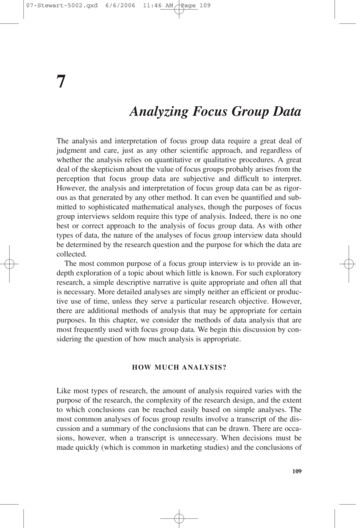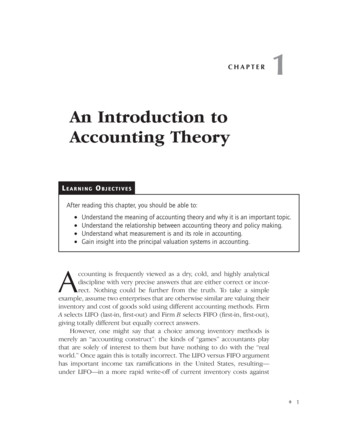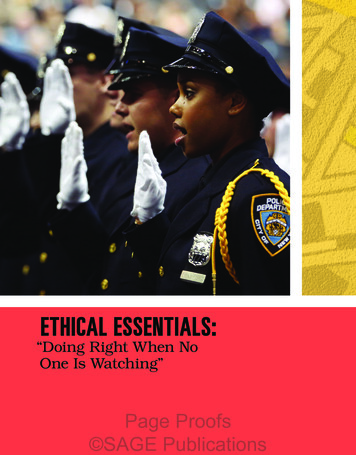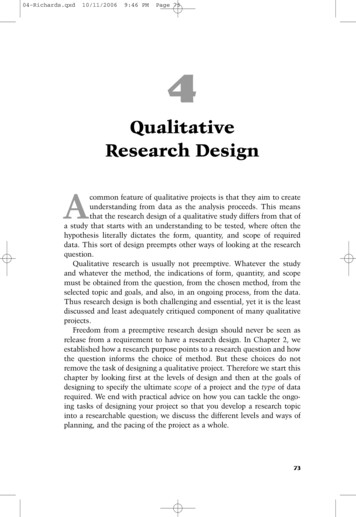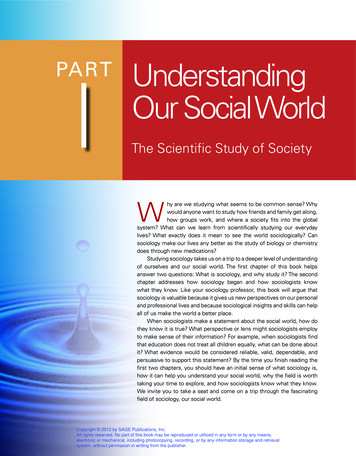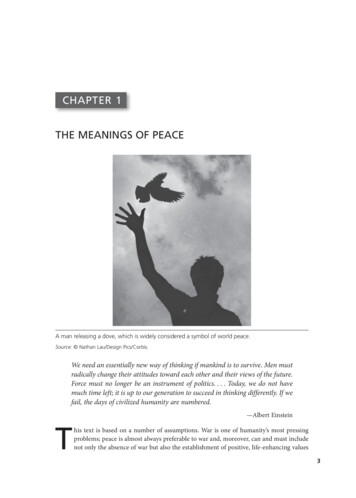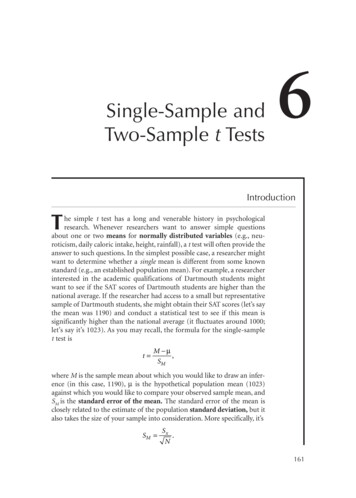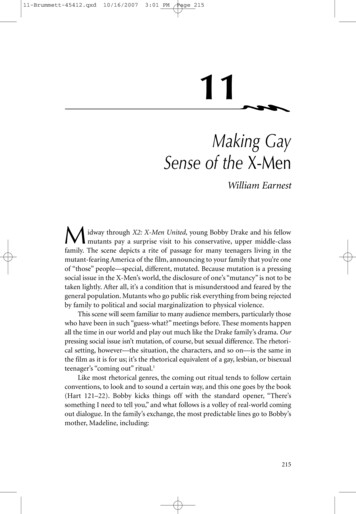
Transcription
11-Brummett-45412.qxd10/16/20073:01 PMPage 21511Making GaySense of the X-MenWilliam EarnestMidway through X2: X-Men United, young Bobby Drake and his fellowmutants pay a surprise visit to his conservative, upper middle-classfamily. The scene depicts a rite of passage for many teenagers living in themutant-fearing America of the film, announcing to your family that you’re oneof “those” people—special, different, mutated. Because mutation is a pressingsocial issue in the X-Men’s world, the disclosure of one’s “mutancy” is not to betaken lightly. After all, it’s a condition that is misunderstood and feared by thegeneral population. Mutants who go public risk everything from being rejectedby family to political and social marginalization to physical violence.This scene will seem familiar to many audience members, particularly thosewho have been in such “guess-what?” meetings before. These moments happenall the time in our world and play out much like the Drake family’s drama. Ourpressing social issue isn’t mutation, of course, but sexual difference. The rhetorical setting, however—the situation, the characters, and so on—is the same inthe film as it is for us; it’s the rhetorical equivalent of a gay, lesbian, or bisexualteenager’s “coming out” ritual.1Like most rhetorical genres, the coming out ritual tends to follow certainconventions, to look and to sound a certain way, and this one goes by the book(Hart 121–22). Bobby kicks things off with the standard opener, “There’ssomething I need to tell you,” and what follows is a volley of real-world comingout dialogue. In the family’s exchange, the most predictable lines go to Bobby’smother, Madeline, including:215
11-Brummett-45412.qxd10/16/20073:01 PMPage 216216—CHAPTER 11So, when did you first know you were a . . . a . . . ?We still love you, Bobby. It’s just . . . this mutant problem is a little . . .complicated.Have you tried not being a mutant?This is all my fault.In response to this last line, a member of Bobby’s entourage sardonicallypoints out that the gene is inherited from males. “So it’s his fault,” he says witha glib nod of the head to Bobby’s father.As rhetorical disguises go, this scene is a bit of a Rorschach test for audiences. Some viewers will see the gay metaphor while others will not. In his NPRreview of the film, for example, Los Angeles Times film critic Kenneth Turanplays excerpts from this very scene while observing, “One of the film’s virtuesis its matter-of-fact storytelling style. This film doesn’t wink at us.” Hence itseems that gay screenwriters Dan Harris and Michael Dougherty infused thescene with enough good-natured humor to prevent it from becoming maudlin,heavy handed, or over-obvious (Chaw; Vary 45).Still, there may be just a little rhetorical winking going on, for directorBryan Singer has been forthright about touting the gay subtext of X-Men andX2 in the press (Applebaum). And actor Ian McKellen told The Advocate thatSinger explicitly invoked an analogy to gay rights issues when he first pitchedthe role of Magneto to him, suggesting that mutants were a perfect symbol forthe social struggles of lesbians and gays (Vary 44). Despite (or perhaps becauseof) this intentional framing of the films as a metaphor for homosexuality andgay rights, Singer and his screenwriters equipped X-Men and X2 with therhetorical stealth needed to fly below the gaydar of many critics and audiencemembers. Nevertheless, such external commentary by those involved with thefilms can serve as a “Psssst! Over here!” sign for anyone interested in sniffingout social issues in disguise. For the critic hunting rhetorical prey, it’s a luckybreak. Hidden rhetorics are usually not as intentional as they seem to be in thiscase. Besides, whether they’re intentional or not, there is no guarantee that theywill be easy to recognize. Indeed, some hidden rhetorics may remain hiddeneven from those who created them.Although Bobby’s coming out is the most apparent manifestation (at leastfor some) of Singer’s metaphoric moral vision for the films, it is hardly the onlyone. Only a few scenes later in X2, Nightcrawler meets Mystique and is intriguedby the unique implications of her shape-shifting ability—implications that,from the perspective of our present analysis, represent the rhetorical strategyof “passing” (Blackmer; Shugart). “Why not stay in disguise all the time, youknow—look like everyone else?” he inquires. “Because,” she replies in sermonicdeadpan, “we shouldn’t have to.”
11-Brummett-45412.qxd10/16/20073:01 PMPage 217Making Gay Sense of the X-Men—217Aside from these scenes in X2, the very premise of The Last Stand2 seemsto push the sexual difference metaphor even further (despite the departure ofX2’s gay director and two gay screenwriters [Vary 45]). Though many mainstream moviegoers may not see the parallels, it seems hard to deny that theX-gene discovered in the third film is analogous to real-world speculation aboutthe existence of a “gay” gene.3 To be sure, Variety’s Justin Chang only slightlyoverstates the case when he says that this central conceit of X3 makes explicitX2’s equating of mutation and homosexuality (41).With vignettes and plotlines such as these thoroughly integrated into allthree films, it seems unlikely that the hidden rhetoric at work here is primarilyabout, for example, class difference (though such a reading may be possible, asWolf-Meyer has done with Batman and Robin).4 In this chapter, I argue insteadthat, throughout all three films, the premise of “mutation” is best understood asa metaphor for non-mainstream sexualities, for doing so unlocks a wide varietyof critical (and, one hopes, meaningful) observations. Indeed, the superherogenre itself seems particularly ready for such discursive mining these days. Afterall, 20th-century comic books are enjoying an unprecedented worldwide audience thanks to the technological advances that have made it possible to bringthese stories to the big screen in believable ways that honor the spectacle of theoriginal material (Coogan 2). Despite the fact that superheroes don’t really exist(as far as we know), the remarkable popularity of the film versions of these stories suggests that other factors may be responsible for their deep resonance withaudiences. Perhaps it’s time to get out the rhetorical calculator and start punching in some equations.And this thought leads me to conclude these opening paragraphs witha note about method. For the present analysis, metaphor is my critical tool ofchoice—the case for a couple of reasons. First, in my view, metaphor criticismis where all form criticism begins. If enough metaphors turn up in enough artifacts, then one is justified in suspecting that a full formal critique might be theway to go. But we are dealing here with only three texts, all of which derive froma single narrative. We may suspect that the X-Men films are formally about, forexample, what it means to be different, but by concentrating on the simple critical equation of mutant gay, we can pay homage to form while getting as muchmileage as possible out of one particular metaphor—which segues to the secondreason for choosing metaphor criticism as my basis: As metaphors go, we willsee in the following pages that this one is highly systematic. In other words, ourmutant gay equation turns out to be the key that unlocks not only Bobby’scoming out scene but also numerous other scenes, plotlines, and characters ineach of the three films. Once transformed in this way, the films can be read productively as ways of thinking about (and making sense of) the social issues thatalternative sexuality presents in early 21st-century America.
11-Brummett-45412.qxd10/16/20073:01 PMPage 218218—CHAPTER 11Background: Percival Pinkerton’s ShadowAs comic-book sagas created by Marvel’s Stan Lee in the 1960s, X-Men, SpiderMan, Fantastic Four, and others often featured narratives that sought to defendthe American way of life against fascist ideology (Schmitt 155; Trushell 151). Abrief examination of Lee’s background makes his motivation for writing thestories in this way even clearer.5The son of Jewish immigrants,6 Lee came of age during the Great Depressionand in his late teens went to work for Marvel forerunner Timely Comics. Therehis writing skills were discovered accidentally but put to good use nonetheless.Among other things, he wrote two of the early Captain America stories. Then in1942, Lee enlisted in the U.S. Army, serving 3 years in the Signal Corps as a writerfor training films and instructional manuals. Hardworking and patriotic, Lee’spost-army career kicked into high gear just as the nuclear age dawned and theCold War turned hot in Korea—more fuel for the fires of imagination.His career then took a most unexpected turn—it almost ended. The causeof this near-demise was a McCarthy-era moral crusade against comic books thatseverely depressed product sales and tarnished the industry’s reputation (Brown18). In 1954, U.S. Senators Estes Kefauver and Robert Hendrickson launched aformal committee investigation into organized crime. A sidelight of this highlypublicized hearing process included looking at how comic books might beresponsible for violent or criminal behavior among young people. To help“answer” these questions, a German-born psychiatrist named Frederic Werthamwas invited to testify. He used the televised hearings to gain popular support forhis ongoing crusade against the comic-book industry for, as fate would have it,the press coverage of his appearance coincided perfectly with the publicationof his book Seduction of the Innocent. These efforts led to the subsequent creation of the Comics Magazine Association of America and the Comic BookCode—”voluntary” efforts by comic-book publishers that amounted to de factocensorship (Park 276).Wertham charged that comic books were leading America’s children astray,encouraging crime, licentiousness, and violent behavior. Of particular note washis conclusion that the standard-issue superhero-sidekick pairing (most notablyBatman, Robin, and Robin’s bare legs) represented a homosexual fantasy relationship (Lee and Mair 90–91; Terrill 493).7 Brown summarizes it this way:“Wertham accused the most traditional of superhero comics of instigating . . .homosexuality. . . . [S]uperheroes, those handsome muscle-bound men runningaround in tights, were obviously gay” (20). Such pseudo-scientific charges todaywould likely draw as much fire as support, but they were utterly incendiary in the1950s (homosexuality would not even be declassified as a mental illness until the1970s [Thompson 85]). The effect of Wertham’s “moral entrepreneurship” wassingular—comic books, their publishers, and (presumably) their readers werehenceforth framed as deviant (Beggan 810; Brown 28–29).
11-Brummett-45412.qxd10/16/20073:01 PMPage 219Making Gay Sense of the X-Men—219Emerging from and informed by this background of economic, technological, political, and cultural upheaval, Lee helped create The Fantastic Four in 1961,Spider-Man in 1962, and X-Men in 1963—superheroes all, a bunch of troubled,gifted outsiders “burdened with self-doubt and existential angst” (“Comic Book”).But it is important to note that 4 months before the first X-Men hit the stands, Leetook a chance (to win a bet) on a World War II story with a ridiculous title thatfeatured human rather than superhuman heroes—Sgt. Fury and His HowlingCommandos (Lee and Mair 161–62). He won his bet. The Fury stories sold welldespite their World War II setting (considered hackneyed according to the conventional wisdom) and despite the fact that they featured a far more diverse castthan had ever been seen before in comic books, including Americans of African,Italian, Irish, and Jewish descent—not to mention a gay character. The latter wasEnglish rather than American (perhaps casting him as a foreigner made it easierto get away with) and went by the somewhat foppish—and quite possiblycoded—name of Percival Pinkerton. According to Lee, Pinkerton’s sexual orientation was never explicitly revealed, only implied (it was 1963 after all). “I didn’tplay up the gay part,” he told NPR, “but somehow you could assume he was gayin reading the stories. But he was brave and nice and friendly and everybody likedhim and he was [just] one of the guys” (“Comic Book”).As for the X-Men, whose initial publication followed quickly on Fury’sheels, Lee claims to have had no specific cultural group in mind other thanteenagers, and that genetic mutation provided a much-needed new plot devicefor the conferring of superpowers (other than, for example, exposure to cosmicrays). “It dawned on me,” he writes, “that mutations often appear in nature, forno apparent reason. . . . Why couldn’t I create a group of teenagers who hadsimply mutated and therefore gained some varied and extraordinary powers?”(Lee and Mair 165). Yet he has also made clear that he intended for X-Men to bean indictment of discrimination generally, to “make it a story against bigotry ofall sorts” (“Superheroes” para. 3).On balance, it seems unlikely that Lee created his mutation saga withoutat least a subconscious appreciation of the potential for reading it through thelens of alternative sexuality. After all, here was a man: (1) who was a patriotic,Jewish World War II veteran, (2) whose professional livelihood had been demonized by cultural conservatives, and (3) who had only months earlier created ahidden gay character in another comic-book series. In other words, he mayhave had a few cultural scores to settle. And as Schmitt has noted, Marvel andother 1960s-era comics publishers were characterized by their radical willingness to engage social issues that were often seen as unacceptable in the eyes ofolder generations (155).Or maybe it was only about acne and angst after all. “It’s funny how peoplewill always read more into what you write than you ever put in there,” Lee toldNPR (“Comic Book”). Either way, he had developed an al
Making Gay Sense of the X-Men William Earnest M idway through X2: X-Men United,young Bobby Drake and his fellow mutants pay a surprise visit to his conservative, upper middle-class family. The scene depicts a rite of passage for many teenagers living in the mutant-fearing America of the film, announcing to your family that you’re one of “those” people—special, different, mutated .



